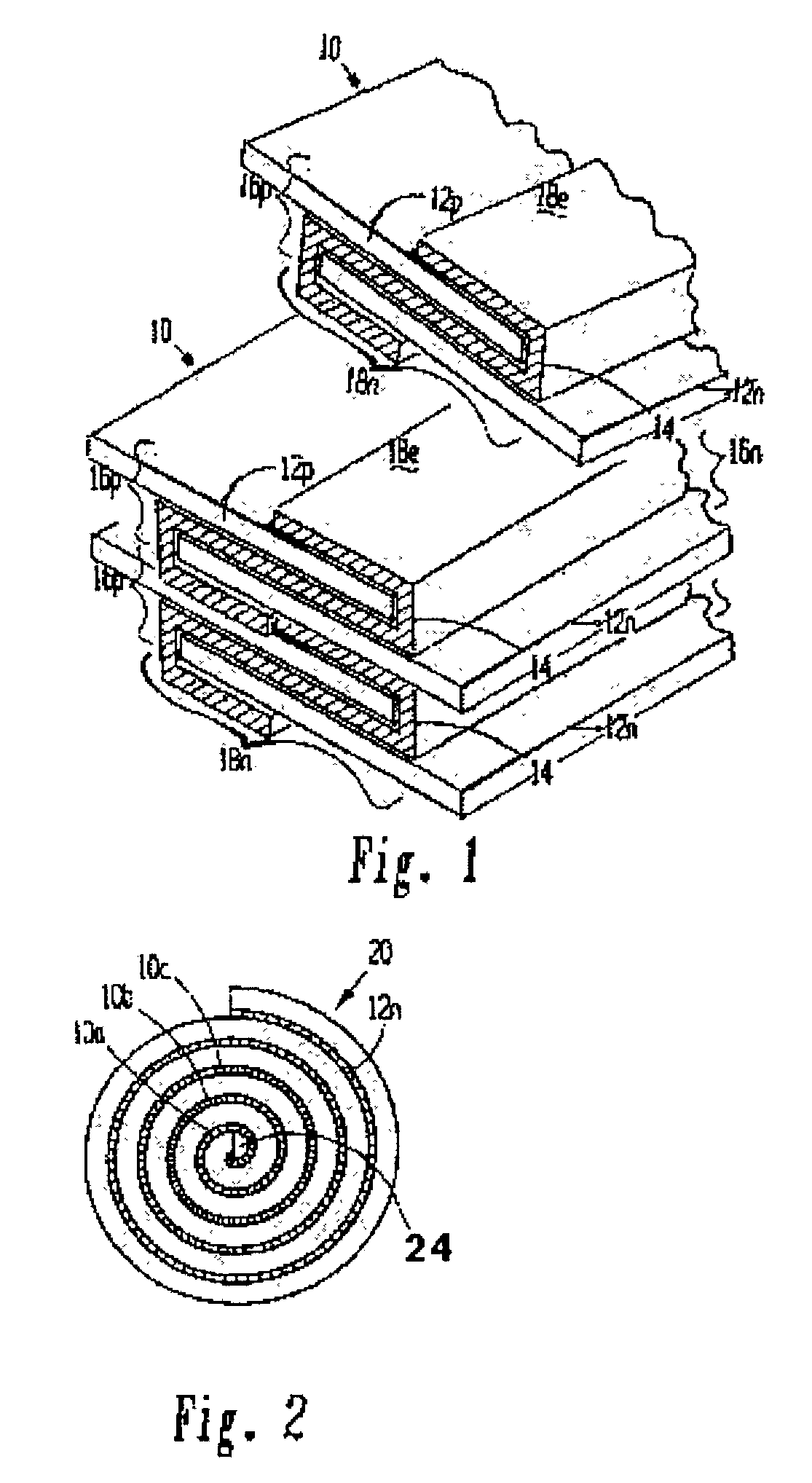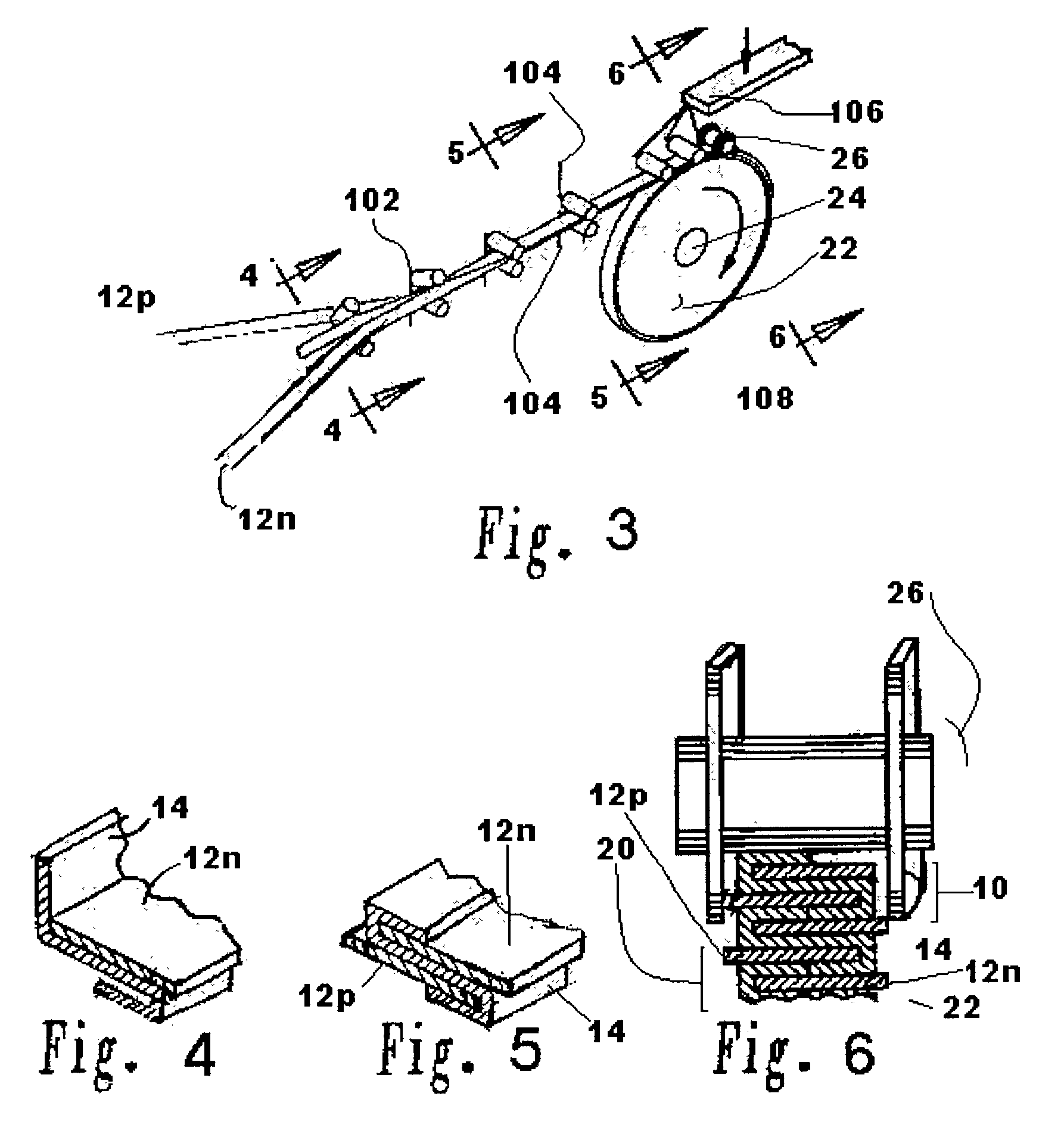Cell structure for electrochemical devices and method of making same
a cell structure and electrochemical technology, applied in the direction of primary cell maintainance/servicing, wound/folded electrode electrodes, sustainable manufacturing/processing, etc., can solve the problems of internal power loss, shorten the useful life of li-ion cells, and often unsuitable older battery configurations to meet these increased demands, so as to achieve effective transmission of power to the effect of greater power outpu
- Summary
- Abstract
- Description
- Claims
- Application Information
AI Technical Summary
Benefits of technology
Problems solved by technology
Method used
Image
Examples
example 1
Lithium Battery Formed with Liquid Organic-Based Electrolyte
[0102]A lithium / organic electrolyte battery can be comprised or fabricated with a carbon / graphite anode; Lithiated cobalt oxide (LiCoOx) with carbon cathode (electron conductor) and polyethylene / polypropylene microporous separator with ethylene carbonate / diethylene carbonate (EC / DEC) having dissolved LiPF6 salt as the electrolyte. A cell preassembly ribbon can be built by individual ribbons of the electrode / separator materials. Each electrode component ribbon is 0.060 mm thick and 6.5 mm wide, the separator is 0.025 mm thick and 6.0 mm wide making the overall dimensions 7.0 mm wide and 0.175 mm thick due to 0.5 mm extended electrode potion. Coiling the cell preassembly on itself approximately 350 times forms a 7.5 mm thick by 130 mm diameter electrode assembly disc. Two cup like subassemblies can be fitted around and edges of the electrode assembly and inserted into a peripheral gasket to join the two cups of the housing. ...
example 2
Lithium Battery with Liquid Electrolyte and Alternative Electrode Materials
[0105]A lithium / organic electrolyte battery can be comprised or fabricated as in Example 1. Li-ion cells are typically fabricated in an uncharged state with Lithiated metal oxide positive electrode and carbon black negative electrode. A Lithium salt, 1.2 M LiPF6, is dissolved in organic carbonates (e.g. EC:EMC 3:7 by weight, where EC:DEC is ethylene carbonate:ethylmethyl carbonate) from EM Science, U.S.A. The cell is initially charged in which Li from the metal oxide positive forms LiC6 at the carbon negative. The cell has about 4.0 volts in its fully charged state. The cathode is selected from two major types of material: Lithium Nickel-cobalt Doped Oxide and Lithium Manganese Oxide Spinel. Both compositions are available from FMC Corp. Lithium Div. Gastonia, N.C. 28054 as Lectro Plus 600 and Lectro Plus 300, respectively. The composition LiNixCoyMzO2 is where Ni x is 0.62O4 is where 2 Li:Mn ratio is 1.02–1....
example 3
Lithium Battery with Polymer-Based Electrolyte
[0110]A lithium / polymer electrolyte bipolar battery can be comprised of LiAl / PEO30—LiN(CF3SO2)2 / V2O5 cell with nanocrystalline V2O5 and LiV3O8 using apolyethylene oxide based polymer (PEO) electrolyte / separator. The LiAl alloy composite anode contains 60% LiAl powder (46.0 atom % Li), 35% polymer electrolyte, and 5% of acetylene carbon black on a copper substrate. A vanadium cathode of similar weight portion has an aluminum substrate. The thickness of the electrode laminates can range between 10 to 30 μm by a casting method. The cell preassembly ribbon can be built up by individually and sequentially painting with stencil guides, etc. the components on the underlying cell preassembly while being coiled on a mandrel. Each component ribbon can be 0.05 mm thick; and each electrode can be 0.95 mm wide and the electrolyte can be 1.00 mm wide overall with the 0.05 mm wide double thick staggered end portions, to define a cell preassembly 1.00 m...
PUM
| Property | Measurement | Unit |
|---|---|---|
| current density | aaaaa | aaaaa |
| current | aaaaa | aaaaa |
| specific power | aaaaa | aaaaa |
Abstract
Description
Claims
Application Information
 Login to View More
Login to View More - R&D
- Intellectual Property
- Life Sciences
- Materials
- Tech Scout
- Unparalleled Data Quality
- Higher Quality Content
- 60% Fewer Hallucinations
Browse by: Latest US Patents, China's latest patents, Technical Efficacy Thesaurus, Application Domain, Technology Topic, Popular Technical Reports.
© 2025 PatSnap. All rights reserved.Legal|Privacy policy|Modern Slavery Act Transparency Statement|Sitemap|About US| Contact US: help@patsnap.com



